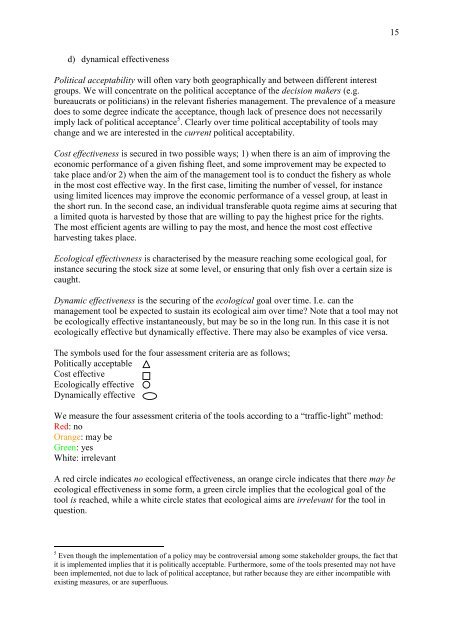Operational tools and adaptive management
Operational tools and adaptive management
Operational tools and adaptive management
You also want an ePaper? Increase the reach of your titles
YUMPU automatically turns print PDFs into web optimized ePapers that Google loves.
d) dynamical effectiveness<br />
Political acceptability will often vary both geographically <strong>and</strong> between different interest<br />
groups. We will concentrate on the political acceptance of the decision makers (e.g.<br />
bureaucrats or politicians) in the relevant fisheries <strong>management</strong>. The prevalence of a measure<br />
does to some degree indicate the acceptance, though lack of presence does not necessarily<br />
imply lack of political acceptance 5 . Clearly over time political acceptability of <strong>tools</strong> may<br />
change <strong>and</strong> we are interested in the current political acceptability.<br />
Cost effectiveness is secured in two possible ways; 1) when there is an aim of improving the<br />
economic performance of a given fishing fleet, <strong>and</strong> some improvement may be expected to<br />
take place <strong>and</strong>/or 2) when the aim of the <strong>management</strong> tool is to conduct the fishery as whole<br />
in the most cost effective way. In the first case, limiting the number of vessel, for instance<br />
using limited licences may improve the economic performance of a vessel group, at least in<br />
the short run. In the second case, an individual transferable quota regime aims at securing that<br />
a limited quota is harvested by those that are willing to pay the highest price for the rights.<br />
The most efficient agents are willing to pay the most, <strong>and</strong> hence the most cost effective<br />
harvesting takes place.<br />
Ecological effectiveness is characterised by the measure reaching some ecological goal, for<br />
instance securing the stock size at some level, or ensuring that only fish over a certain size is<br />
caught.<br />
Dynamic effectiveness is the securing of the ecological goal over time. I.e. can the<br />
<strong>management</strong> tool be expected to sustain its ecological aim over time? Note that a tool may not<br />
be ecologically effective instantaneously, but may be so in the long run. In this case it is not<br />
ecologically effective but dynamically effective. There may also be examples of vice versa.<br />
The symbols used for the four assessment criteria are as follows;<br />
Politically acceptable<br />
Cost effective<br />
Ecologically effective<br />
Dynamically effective<br />
We measure the four assessment criteria of the <strong>tools</strong> according to a “traffic-light” method:<br />
Red: no<br />
Orange: may be<br />
Green: yes<br />
White: irrelevant<br />
A red circle indicates no ecological effectiveness, an orange circle indicates that there may be<br />
ecological effectiveness in some form, a green circle implies that the ecological goal of the<br />
tool is reached, while a white circle states that ecological aims are irrelevant for the tool in<br />
question.<br />
5 Even though the implementation of a policy may be controversial among some stakeholder groups, the fact that<br />
it is implemented implies that it is politically acceptable. Furthermore, some of the <strong>tools</strong> presented may not have<br />
been implemented, not due to lack of political acceptance, but rather because they are either incompatible with<br />
existing measures, or are superfluous.<br />
15

















